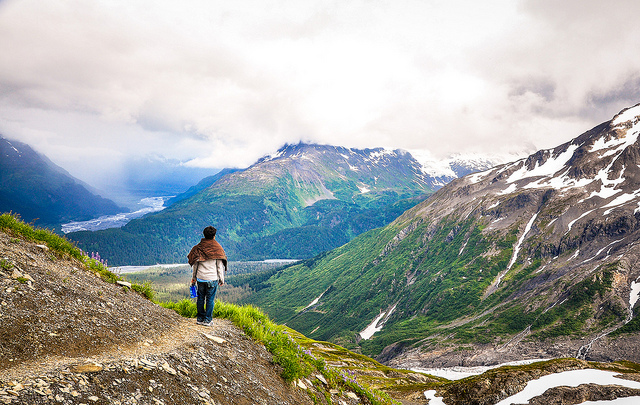
“The experienced mountain climber is not intimidated by the mountain. He is inspired.” ~William Arthur Ward
I like to hike in the mountains. It is such an amazing relief from the day-to-day stress of my position as a healthcare executive.
Hiking settles my mind and puts the drama of my job aside. I am fifty-nine and have had my share of experiences, but I never feel more at peace and complete than I do on a trail in the mountains
I spent a week hiking with family in Maine this past summer. I was halfway through a certified coach training program and diving deep into the study mindfulness and meditation. As I walked the mountains, I found myself wondering why I loved to hike and thinking about hiking in the context of coaching, mindfulness, and meditation.
Whenever I reached the top of a climb, I would take a few minutes to collect my thoughts and jot them in my journal. When I got home, I discovered that I had found five fundamental lessons from my hikes.
1. Much of our suffering in life is the result of a desire to have reality be different than it actually is.
One day, when I about three hours from base, an unexpected rainstorm popped up. I was not really prepared to be hiking in the rain. Much of the trail that day was steep, exposed, lichen covered granite that gets really slick in the rain. That can be a real concern since falling at my age is not fun!
My first reaction was to be angry and frustrated at the turn of events. Then I stopped and began to laugh at myself. Being angry about an act of nature that I could not change made no sense at all.
I surrendered to my circumstances and adjusted my pace and expectations. I worked on being aware of my surroundings and began to get back into meditative flow, which is the best part of hiking for me. It ended up being a great hike.
Being present in the moment, even when it is a moment that we did not expect and would not choose, is a great antidote to our tendency to create internal distress by wishing that our circumstances were different.
We can find focus and even delight in almost any circumstance if we allow ourselves to be present with ourselves and the experience.
2. Getting what we cherish most usually means letting go of something else.
I was hiking a trail with Lucy, my twenty-one year old daughter. Lucy and I had hiked this particular trail together several times in the past. The first time she was so small that I actually carried her!
The six-mile hike that day had several of steep sections and scrambles, and I always like the challenge that it presents. On that day, twenty years after I first hiked the trail with Lucy, I was struck by what a strong hiker she had become.
At 5’10” she is fast and graceful with a long stride. She seemed to bounce from rock to rock without effort. On the other hand, I was feeling much older and I could keep pace with Lucy only by pushing myself.
I felt a fascinating mix of emotions. I was full of pride watching my daughter and celebrating the strong and delightful woman that she had become. At the same time, I was a bit sad as I thought about my own aging and how I was never again going to be able to hike like as well and easily as Lucy.
As hikers, Lucy is entering her peak, while I am in moving into decline. Then it struck me: celebrating Lucy’s blossoming and watching my own aging are different sides of the same coin. The passage of time that is responsible for Lucy’s strength is the same passage of time that is responsible for my becoming weaker.
In most things, getting what we want comes at a cost somewhere else in our lives. We need to be ready for the great things that come in life but also prepared to give up some things to achieve our goals.
3. Our perspective dramatically influences our experience of the world.
One of my favorite hikes of the week included a very steep climb of about 900 vertical feet. There is nothing technical about the climb, but it is a narrow trail with a lot of scrambles and some scary looking drop-offs.
As I came down the same trail that I went up, I noticed that, while it was the same path that I had been on earlier in the day, walking it in a different direction made it seem entirely new. Going down the path rather than up stressed different muscles and joints, required different skills, moved at a different pace, and made me anxious in different spots.
The views seemed new and fresh even though I had been at the same spot just hours before. I realized that even if we may be in the same spot as we were yesterday, our approach to the day can make it brand new. We need to pay attention to how we are in a place, not just where we are.
4. Appreciating both the climbs and descents are important to a great journey.
While I have a lot of friends who like hiking relatively flat trails, I am a mountain hiker. Nothing feels better than getting into the rhythm of climbing up a steep mountainside, and the thrill of hitting the summit and seeing the vast and beautiful vistas from the top is extraordinary.
The climb down, however, never seems as rewarding and I am sometimes tempted to rush down to finish the hike.
On one of my hikes down the mountain this summer, it dawned on me that most of my life has been a series of exciting ups and inevitable downs. No moment at the top has ever lasted forever, and tough descents are required if I am going to make another beautiful climb.
I could see that neither time at the top of the mountain nor time at the bottom is permanent, and that both experiences are important and intertwined. They are the markers that help to make sense of the larger journey.
The only way to get from one place to the next is to put one foot in front of the other, whether it is on the way up or the way down.
5. Beauty lies at every step on our path.
I am a photographer and I love the huge landscapes that I find when I hike. The peaks and valleys melting off towards the horizon, the interplay of light and shadow across the mountainsides, and the rocky crags against a great sunset touch me at the deepest level and I have piles of photos that try to capture these moments.
This summer, I began to pay more attention to the small bits of beauty along the way. On one hike, I never made it to the top of the mountain because I found myself stopping so often to photograph patterns of bark on the trees, small wildflowers, a spider in its web, delicate mushrooms, tiny flowers, and the colorful bits of moss, lichen, and groundcover that I found each step of the way.
Every spot on the trail had its own beauty, and all I had to do was to slow down enough to see it. Real beauty is found in the big moments of our lives and in the tinniest corners of our lives as well.
Photo by Salil Wadhavkar
About Tony Zipple
Tony Zipple is a licensed psychologist and a certified professional coach who makes his living as the CEO of a large mental health center in Kentucky. Most days, he would rather be hiking with his wife, his two daughters (including Lucy who is in the photo) and his close friends.













